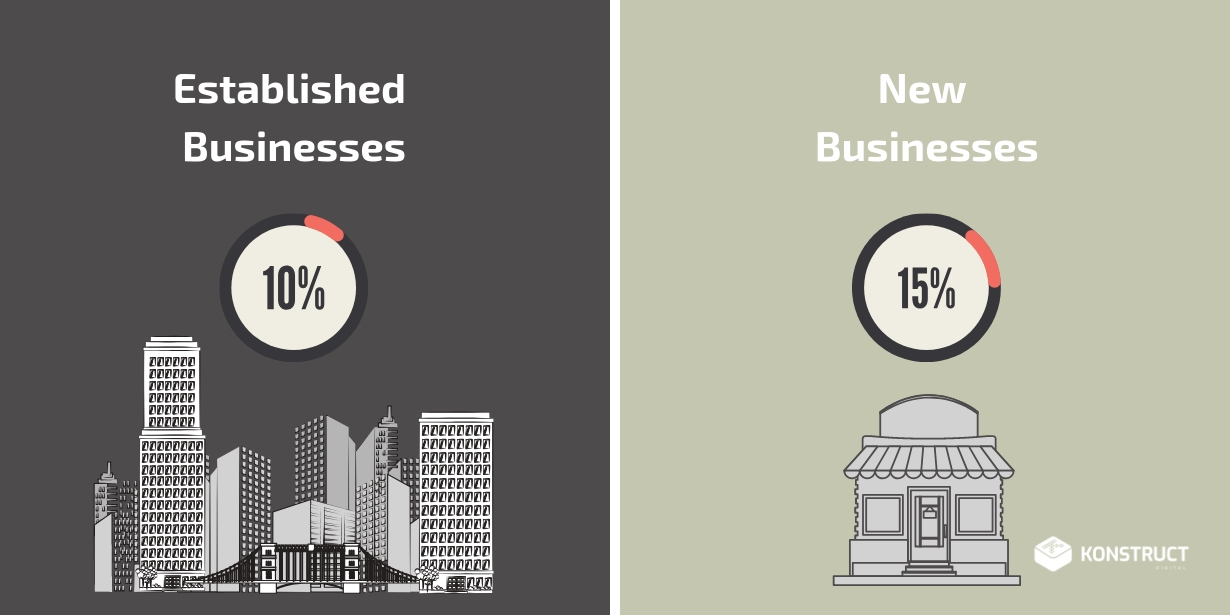As marketers and consultants, business owners often ask us how much they should invest in marketing for their business to thrive and gain market share. The problem with that is, there is no one clear answer to determine what the optimal amount is until we fully understand your business.
When looking at how much a business should spend on its marketing, typically the value is expressed as a percentage of revenue or desired revenue. We’ve worked with clients on the low end around 4%, all the way up to 30%. That’s a huge range. Understanding of your business model, brand, the industry you operate in, and your growth goals can help us narrow in on a number that makes sense for your business.
We have a few rules of thumb and general guidelines we use to help determine what a business should be investing in their marketing campaigns.
Use the Ten Percent Rule to get a Marketing Budget Baseline
If you’re looking to get a quick idea on how much you should invest in marketing, the ten percent rule can give you a pretty good idea of what your marketing budget should be.
The idea behind the ten percent rule is that an established business should be spending roughly 10% of its gross sales revenue on marketing and advertising.
The concept is simple. Let’s say your gross sales revenue target for this year is going to be $1 million. If you’re going to invest 10% into your marketing budget then you’re going to invest $100,000.
What about new businesses?
New businesses are an exception. Given that they are not established within their industry, they will not have the recognition a more established company would. Additionally, there are start-up costs in getting your marketing engine and brand off the ground. In their case, it’s recommended that new companies invest 15-20% of their gross sales revenue on marketing.

Should you use last year’s revenue number?
If you want your revenue to be similar to last year, then last year’s revenue is a good starting point. If you want to grow, then you need to use what you want your revenue to be.
What other factors go into determining a marketing budget?
There are many other things you need to take into consideration when determining your marketing budget. Depending on the margin of the product you’re selling and how many products you sell, you may have to invest more or less into your marketing.
But, what about the external factors that may have an impact on how much you need to invest in your marketing campaigns? Let’s take a look at what may have an effect on how much you need to invest in marketing.
Your Industry
Your industry plays a huge role in determining how much you should be investing in marketing. There are statistics on how much each industry is investing on average into their marketing campaigns. This is a good guideline as to how much of your margin you should set aside for marketing.
Think of it this way, if you want to be competitive, you’re going to need to invest a comparable amount to your competition. If you invest more into well-implemented marketing campaigns than your competition, you’ll have an opportunity to win over more of the market share.
Amount of Gross Sales Revenue invested into Marketing by Industry:
- Consumer packaged goods: 24%
- Consumer services: 15%
- Tech Software / Biotech: 15%
- Communications / Media: 13%
- Mining / Construction: 13%
- Service Consulting: 12%
- Education: 11%
- Healthcare / Pharmaceuticals: 10%
- Retail Wholesale: 10%
- Banking / Finance / Insurance: 8%
- Transportation: 8%
- Manufacturing: 8%
- Energy: 4%
Your Brand
One of the most important determinants of how much you should invest in marketing campaigns is the overall strength of your brand.
Think of it this way, if you’re going against a big, well known company, it’s going to take more investment to steer their customers towards an alternative. If your brand isn’t as established as a well known one, it’s going to take a lot of marketing to make people aware of your brand and for you to be able to win over the market.
Business Model
Another important consideration is your business model. A business that is marketing to sell a product or service to another business or a “B2B” company will need to have a different budget than a company that is marketing to sell a product or service to a consumer.
To give you some context, a business purchaser is likely to have a different marketing and sales cycle than a consumer product purchaser. There are some similarities in the way they search for information, but the style and the size of the market is different.
Here is a breakdown of the average percentage of Gross Sales Revenue invested in marketing campaigns for B2B businesses compared to B2C businesses.
| Type of Company | Marketing Spend % |
| Overall | 8.4% |
| B2B Product | 6.9% |
| B2B Services | 8.6% |
| B2C Product | 9.5% |
| B2C Services | 10.4% |
As you can see, B2C businesses invest more of their gross sales revenue into marketing campaigns than B2B businesses. It’s important to know what kind of target market you’re going after in a B2B as well as a B2C context to determine how much to invest. Some target markets and competitive industries require a more aggressive marketing strategy than others.
How to allocate your marketing budget
How you allocate your marketing budget is going to be different based on a lot of the same factors above, but as a baseline I typically recommend the rule of 3rds. One-third traditional, one-third-digital, and one-third special projects or marketing infrastructure.
Special projects or marketing infrastructure might include: re-branding, major website projects, marketing automation, and analytics/reporting.
How you split your traditional and digital marketing budgets will largely depend on your audience. (I sense a future blog post coming your way!)
—
Your marketing is not an expense. Don’t underinvest.








